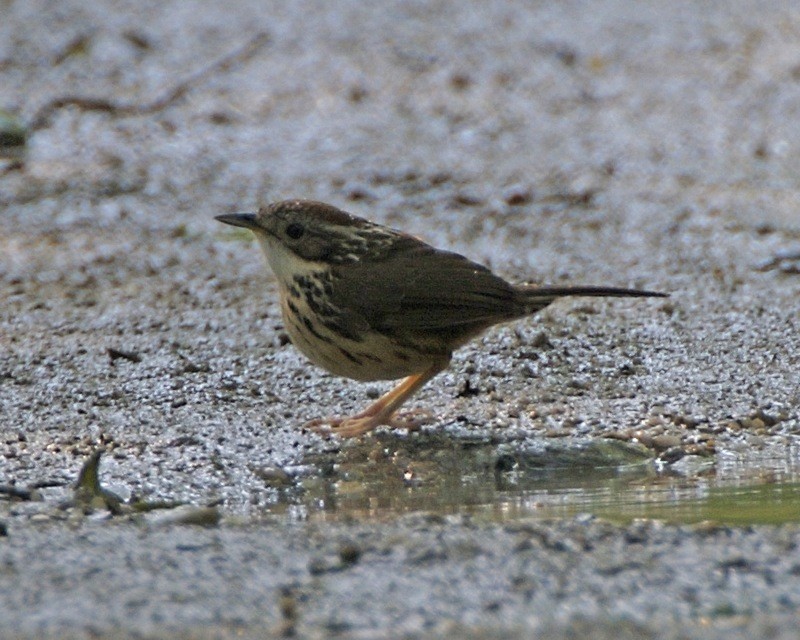Puff-throated Babbler
A species of Typical Ground-babblers Scientific name : Pellorneum ruficeps Genus : Typical Ground-babblers
Puff-throated Babbler, A species of Typical Ground-babblers
Botanical name: Pellorneum ruficeps
Genus: Typical Ground-babblers
Content
Description General Info
 Photo By Lip Kee , used under CC-BY-SA-2.0 /Cropped and compressed from original
Photo By Lip Kee , used under CC-BY-SA-2.0 /Cropped and compressed from original Description
Puff-throated babblers are brown above, and white below with heavily brown streaks towards the breast and belly. They have a chestnut crown, long buff supercilium and dusky cheeks. The throat is white, and is sometimes puffed out giving it the English name. Puff-throated babblers have strong legs, and spend a lot of time on the forest floor. They can often be seen creeping through undergrowth in search of their insect food, looking at first glance like a song thrush. Some subspecies have streaks on the mantle while others, especially in Peninsular India, are unstreaked. The widespread distribution with population variations has led to nearly thirty subspecies being described. The nominate population is found in peninsular India (excluding the Western Ghats). The population in the northern Eastern Ghats is paler and has been called as pallidum while a well marked dark form occurs in the southern Western Ghats which has been named granti (includes olivaceum). The western Himalayas population is punctatum (includes jonesi) and in the east is mandellii which has streaking on the back and nape apart from having call differences. In the east of India, south of the Brahmaputra River occurs chamelum while ripley is found in a small region in eastern Assam (Margherita). Further east in Manipur is vocale and pectorale in Arunachal Pradesh and northern Burma with stageri further south, followed by hilarum, victoriae and minus. Further east are found shanense, subochraceum, insularum, indistinctum, chtonium, elbeli, acrum, oreum, dusiti, vividum, ubonense, euroum, deignani, dilloni and smithi. Several others have been described and many populations are difficult to assign to subspecies. This is the type species for the genus Pellorneum and its generic placement is assured although other species currently included in the genus may be reassigned. 
Size
17 cm
Colors
Brown
Yellow
Bronze
Gray
White
Nest Placement
Shrub
Feeding Habits
Puff-throated Babbler primarily consumes insects, exhibiting foraging behaviors such as hunting in leaf litter. It displays unique dietary preferences for specific insect types and has adapted to feed at various times, setting it apart with its diverse insectivorous diet.
Habitat
The puff-throated Babbler typically dwells in the understorey and floor niveaux of various forest types, including deciduous, broadleaf evergreen, and teak forests. They are prevalent in secondary growth habitats and frequently inhabit bamboo thickets, tea gardens, scrub areas, and sholas. The bird is also found in lantana thickets at forest margins, thickets in ravines, and along watercourses, adapting to regions with acacia and Ziziphus vegetation. Their altitudinal range extends up to 1900 meters, favoring areas generally below 1000 meters in some regions like Bhutan.
Dite type
Insectivorous
General Info
Feeding Habits
Bird food type
Behavior
Puff-throated babblers vocalize often. Their calls are a series of whistling notes ascending in scale. Some calls have been transcribed as he'll beat you, pret-ty-sweet. The calling can be persistent. The breeding season is mainly during the rainy season. They build a nest on the ground at the base of bush and is a dome of leaves and twigs with an entrance on the side. The opening usually points downhill when the nest is on sloping ground. The clutch varies from 2 to 5 eggs, with northern populations tending towards larger clutches. Parent birds run rodent-like in the undergrowth as they move in and out of the nest. Young birds fledge and leave the nest about 12 to 13 days after hatching. 
Distribution Area
This bird is a common resident breeder in the Himalayas and the forests of Asia. Like most babblers, it is not migratory, and has short rounded wings and a weak flight. Its habitat is scrub and bamboo thickets and forages by turning over leaves to find insects. 
Species Status
Not globally threatened.
Scientific Classification
Phylum
Chordates Class
Birds Order
Perching birds Family
Jungle babblers Genus
Typical Ground-babblers Species
Puff-throated Babbler